Google Nexus 5 Review
by Brian Klug on December 5, 2013 8:00 AM EST- Posted in
- Smartphones
- LG
- Android
- Mobile
- Snapdragon 800
- Android 4.4
- Nexus 5
Display on mobile devices is one area where we’ve seen considerable improvement. Pixel density has gone up, contrast ratios have improved, and the emphasis on low power in a platform gated by its battery size means there’s always innovation happening.
In the case of the Nexus 5, there’s a considerable jump in resolution, from the WXGA 1280x768 display on the Nexus 4, to the now-standard 1080p. The biggest change is an obvious shift in aspect ratio from 15:9 to 16:9 once more. Back with the Nexus 4 and Optimus G, I noted just how surprisingly noticeable that extra 48 pixels of width was. Although we tend to think in absolute display resolution and talk about it quite a bit, Android uses display independent pixels or dips in order to keep layouts display density agnostic and support a wide variety of screen sizes and resolutions. Nexus 5 implements the 480 ppi or xxhdpi screen density, whereas Nexus 4 implements 320 ppi or xhdpi density. The result is that the Nexus 5’s display is 360x592 dips in size, compared to 384x592 dips for the Nexus 4, coming in 24 dips narrower. It’s important to note however that this change is intentional to maintain Android’s DPI independence, even if it does mean less overall real-estate in apps and browser.
Display quality is a big deal in the Android space, with lots of variance between devices. In the case of the Nexus 5, I started by tracking down the display type. If you recall, 5-inches with 1080p is a resolution we’ve seen before in the Droid DNA and Butterfly. From what I can tell, the Nexus 5 uses a very similar evolved version of that panel, a JDI (Japan Display, Inc) 1080p display with in-cell touch courtesy Synaptics ClearPad 3350 solution.
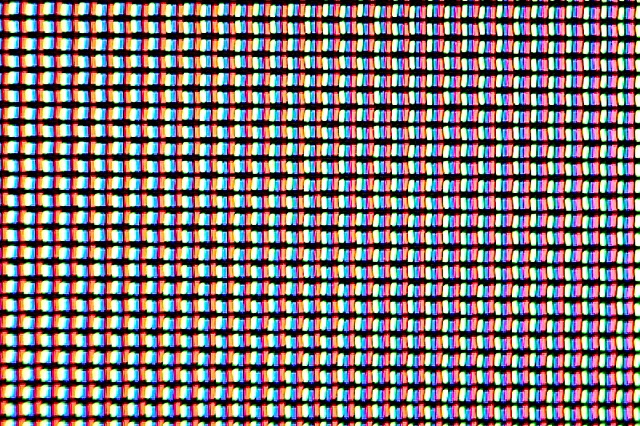
The other question was whether Nexus 5 also uses a PSR (Panel Self Refresh) type display. This display is indeed a MIPI command mode panel, the same kind of system, so yes it does include those features. An additional change is the addition of software vsync in Android 4.4, which to my knowledge the Nexus 5 does use, you can see this pop on and off depending on what’s happening on-screen if you monitor surfaceflinger. Those improvements should decrease latency and improve how sticky animations feel.
To characterize display quality and accuracy, we turn to our usual display measurements.
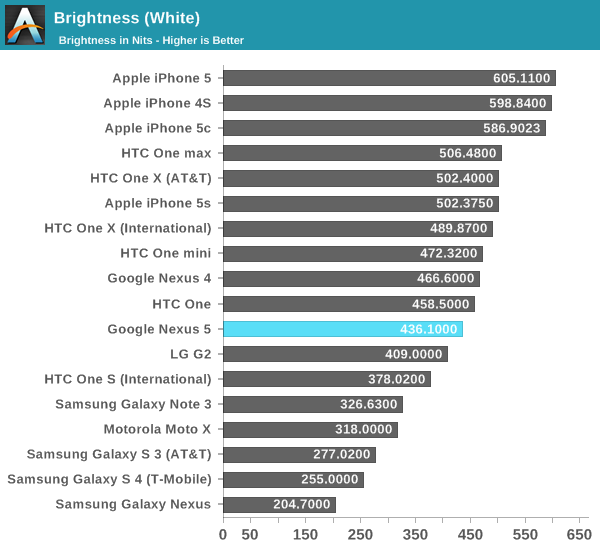
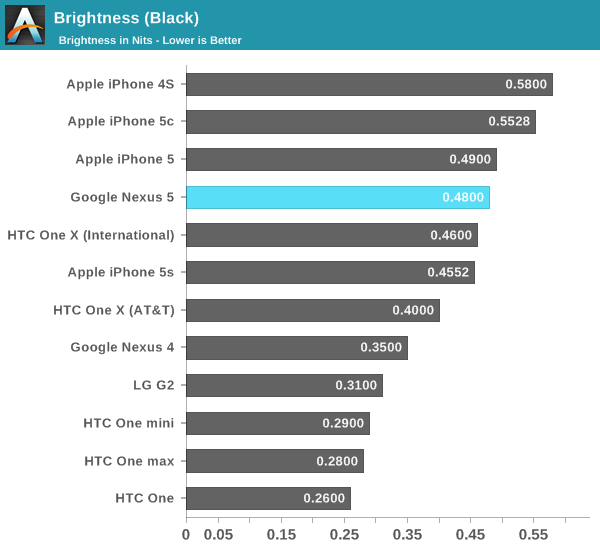
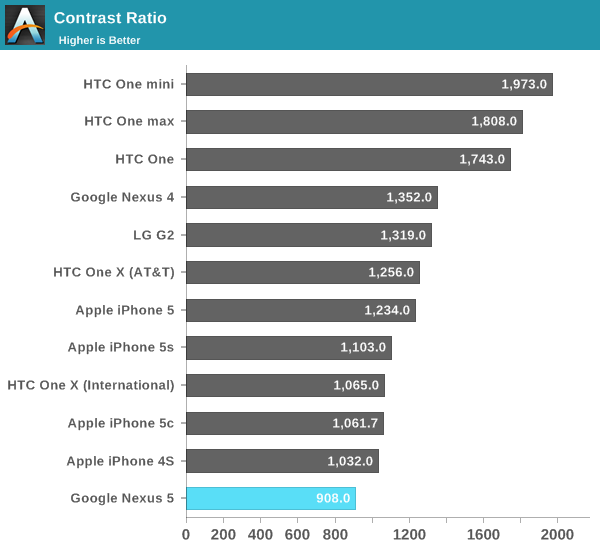
The Nexus 5 doesn’t go quite as bright as Nexus 4, but it’s still a very bright display. Blacks and contrast are a bit disappointing though, contrast is definitely on the lower end, but not bad. I definitely haven’t been put off by them. I also haven’t noticed any of the distracting dynamic brightness behavior I have on other handsets, which is awesome.
My only criticism is that I wish Nexus 5 would allow its auto screen brightness algorithm to go dimmer when in dark scenarios. There’s still more dynamic range in the manual brightness setting bar than there is for the auto brightness routine from what I can tell.

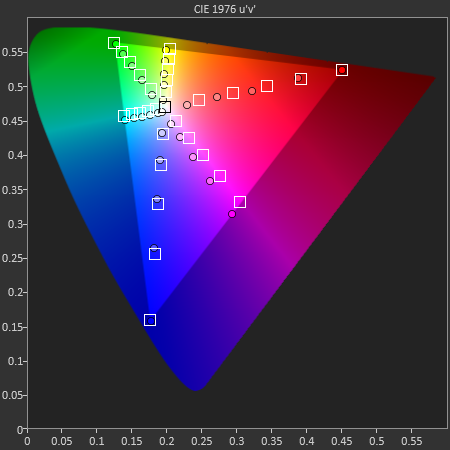
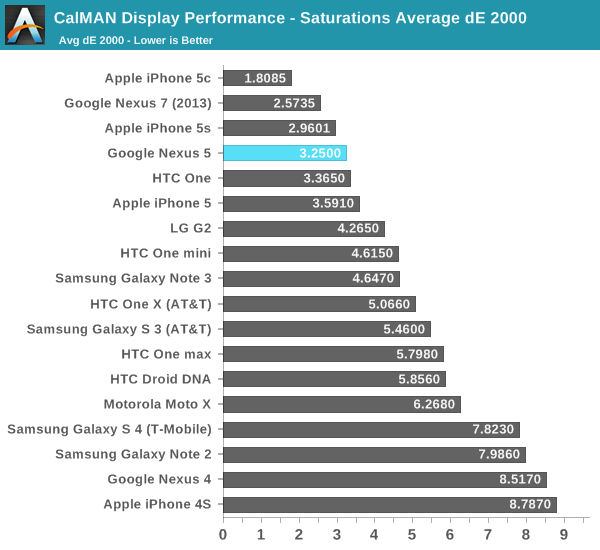
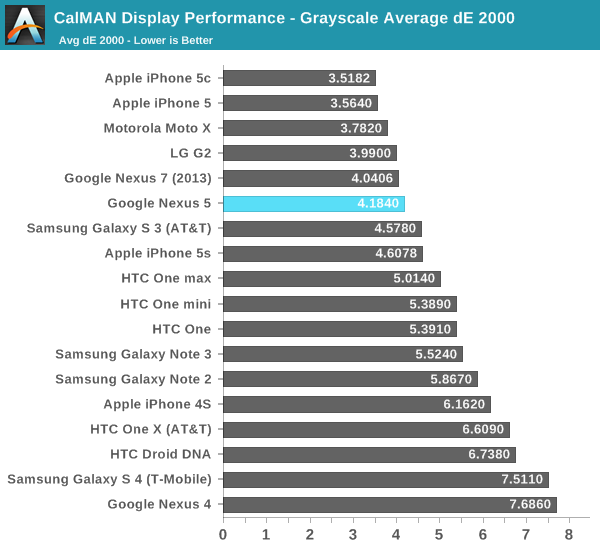
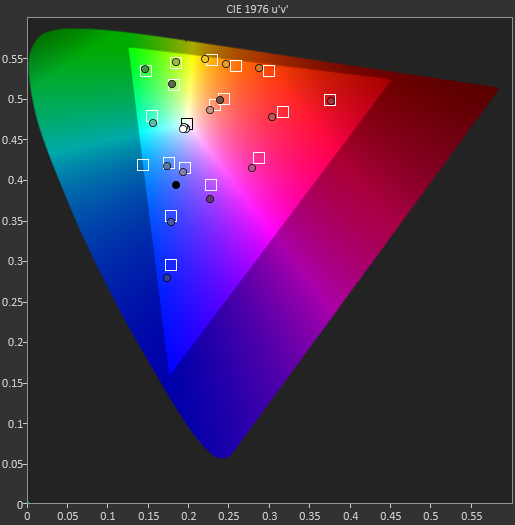
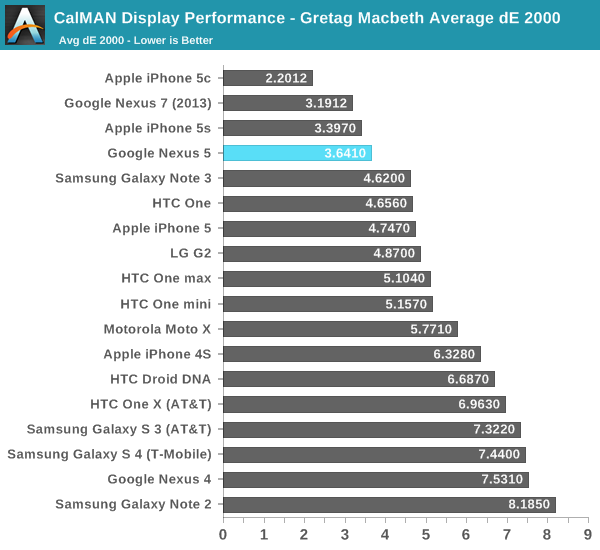
The new Nexus 7 impressed me with how accurate its display was in terms of color reproduction, beginning with Google stating it targeted sRGB (the color space for both the web and Android) calibration for it. The Nexus 5 seems to have done the same, and wowed me with the best GMB color checker Delta-Es we’ve seen from any Android handset. In addition, the Nexus 5 has none of the saturation boost that’s sadly quite pervasive right now, instead giving the right evenly spaced saturation stepping on its color channels. The Nexus 7 has slightly lower Delta-E, but it’s clear to me that Google has made color calibration an emphasis on the Nexus line.
It’s interesting to hear some Nexus 5 users complain that the display seems undersaturated, since that kind of end user feedback reflects subjective comparison. It also suggests to me that a large percentage of the population doesn’t know what some colors or system elements actually should be. Even for me, looking at the green elements inside the Google Play store on the Note 3 in movie mode or Nexus 5 initially seemed slightly more muted than normal. The reality is that this is what they actually should look like. We’ve just become accustomed to their oversaturated appearance on virtually every other device.
This kind of expectation about what looks right and what doesn’t is rather telling for the state of display calibration in Android handsets, and how OEMs have used oversaturated colors to increase retail shelf appeal. Unfortunately the reality is that oversaturated colors do seem to win taste tests among shoppers, the same way that TVs in most big boxes do. We’ve been looking at them for so long that well calibrated displays like Nexus 5 initially do look noticeably different.
The end result is easy to sum up, however – Nexus 5 has the best calibrated display I’ve seen so far in any Android handset. It’s also leaps and bounds more accurate and controlled than its predecessor display in the Nexus 4.


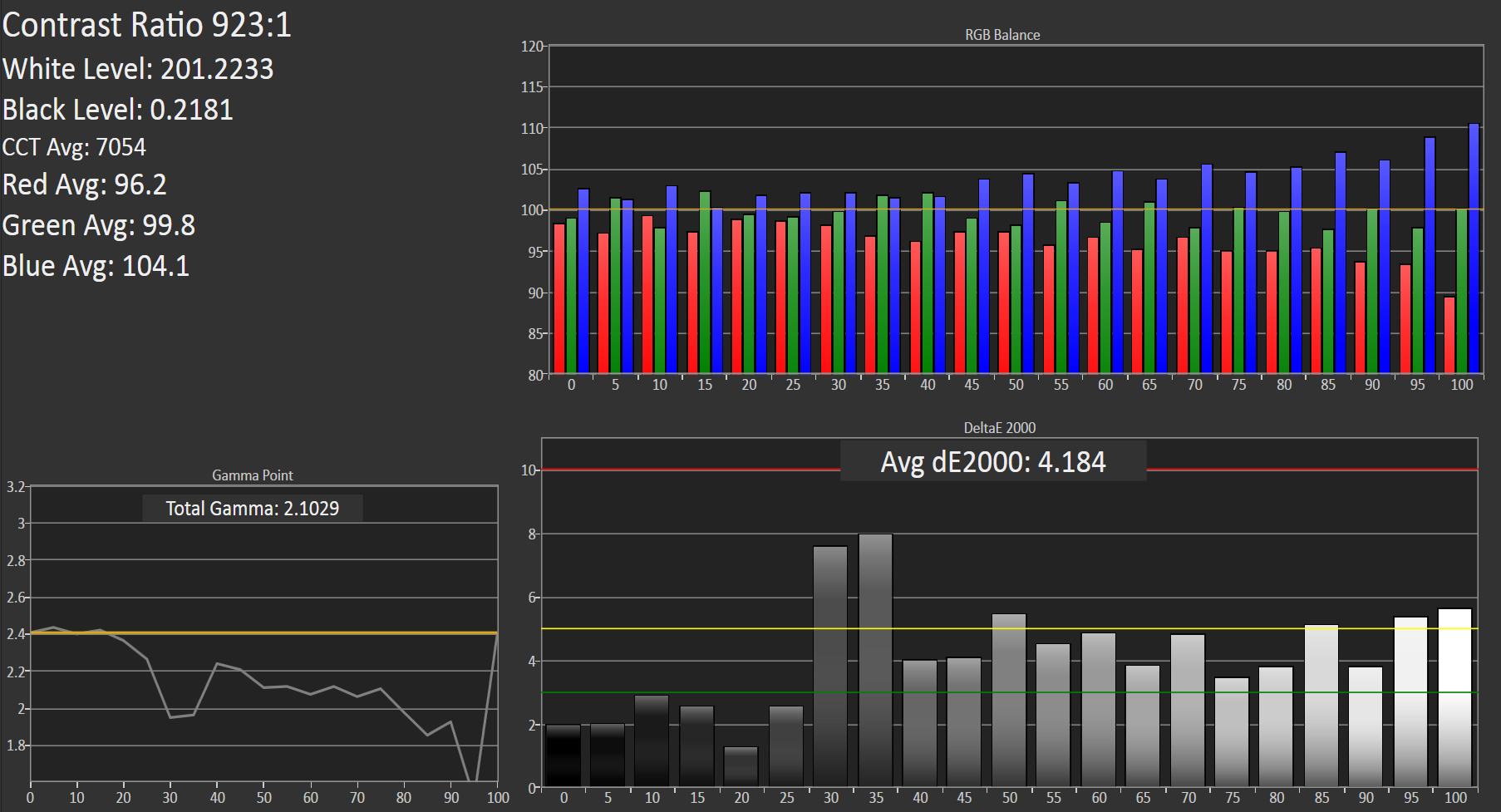








231 Comments
View All Comments
A5 - Thursday, December 5, 2013 - link
You can't just ignore the app count when talking about these devices. No way the 2520 is the best tablet.thunderbird32 - Thursday, December 5, 2013 - link
Even as far as non-Android/iOS tablets go the 2520 isn't the best. I'd much prefer Dell's Venue tablets. Full version of Windows on a Bay Trail SoC is so much more useful than RT on ARM.zoetrope - Thursday, December 5, 2013 - link
Why don't you WinTards troll elsewhere? Enough of the whining and "poor me" attitude. The intertubes is big enough for your ilk, go visit a WP echo chamber like wpcentral.com and keep out of comment sections if you can't stay on topic.Wade_Jensen - Thursday, December 5, 2013 - link
I am thoroughly against insulting people in such a manner, but WinTard is possibly the most hilarious thing since S-gimmick and S-fail.hrrmph - Thursday, December 5, 2013 - link
The greatest tablet? The 2520?Well maybe almost. Nokia specs show the Micro-SD slot to be a crippled version with a 32GB max capacity.
For many people, the low storage capacity makes it DOA, falling down straight out of the gate. There are just too many competing devices that have 64GB capable Micro-SDXC slots.
Of the course, the Nexus 5 is a zero in this category, since it has no slot for Micro-SD of any type.
jimbo2779 - Friday, December 6, 2013 - link
I'm going to ignore the childish name calling for a moment and just say that while I am a big fan of WP and windows tabs I seriously doubt the 2520 is going to be the best tablet going, on paper it has decent hardware and Nokia build quality if great it is still going to be running RT.RT has/had a huge amount of potential but without more app support it will never draw in the crowds and that will in turn not lead to more apps so it is a vicious cycle that I doubt will be changing any time soon. As an OS it is pretty great and you only need to look at some of the fan vids of it online where people are gaming on the tab while watching a video on a TV or vice versa, there is some serious potential to it but without the app support it is likely to stay at potential.
As for WP reviews I do agree that it is very disheartening to not even have some cursory reviews/overviews of them. It really wouldn't be that hard to get a few of the key devices and at least battery test them. At this point a few days of testing would really go a long way to showing how they stack up in terms of battery life.
It is disappointing to not have any real consideration for what is a good phone OS and its devices. Market share is increasing and as it does so will app support and if AT is not careful they could be in a position where WP is more of a serious player (it already is in some parts of the world) and none of the writing staff will have much of an idea about what it is all about.
BoneAT - Thursday, December 5, 2013 - link
Having a whole year to work on the device an two to work on Key Lime Pie, I'm surprised how rushed the Nexus 5 feels. The camera thing is a mess as if there were very, VERY late decisions to include OIS and exclude the new API, and ppl. are reporting wakelocks all over the place.Build quality is extremely worrysome based on drops tests, each ending brutally plus the speaker placement blocks clear sound coming through, boyz @XDA improved it significantly drilling small holes into the plastic underneath.
And then there's the battery - it seems Google understands the flagship concept as far as specs and SW goes, but 4hr SoT on normal use of Google services is NOT flagship level. With a price bump I wonder how they failed to address the Nex4's biggest issue (not much real world improvement based on dozens of N5 XDA users).
Now when you have the camera focus right, when you manually improve the speaker, when you protect it from the smallest drops and when you use all around (excluding all non-KitKat compatible apps), the Nexus 5 is the most successful realization of the Google Phone. These annoyances however makes it a questionable buy, never mind the price tag. The Moto X might just be a better buy considering you get two for one Nexus 5.
THX - Thursday, December 5, 2013 - link
I'm guessing you went with a different phone and are trying to justify your purchase by trashing the shinier, newer, more performant option. :)Maybe I'm missing something but how is the Moto X half the cost of the $350 Nexus 5?
BoneAT - Thursday, December 5, 2013 - link
No criticism, no improvement, buddy. I'm a Nexus user so hit any miss on your cyber bullying attempt, but thx for spotting out my Moto X - Moto G mix-up.THX - Thursday, December 5, 2013 - link
Nexus 4 user? Just sell your phone and get the 5.And I think anyone here would rather have a single fast phone than 2 slow ones, or was there a specific use-case you had in mind?